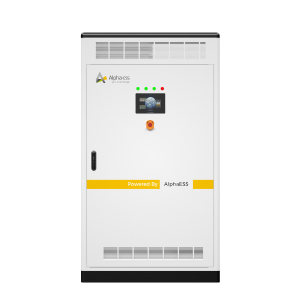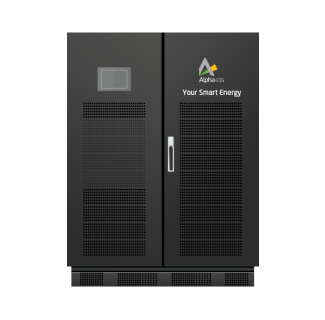C&I ENERGY STORAGE SYSTEM
(2024年)https://www.alphaess.com/commercial-and-industrial-energy-storage-system
STORION SERIES
Our commercial energy storage and commercial battery storage solutions offer from 30kW to 30+MW. We have delivered hundreds of projects covering most of the commercial applications such as demand charge management, PV self-consumption and back-up power, fuel saving solutions, micro-grid and off-grid options.
STORION-LC-372
Battery Cabinet (Liquid Cooling)372.7 kWh
AlphaCS-H20-DC-LC
Container Solution (Liquid Cooling)3354.6 kWh
STORION-H30
30 kWMax. 96.77 kWh
STORION-T30
30 kW28.7 ~ 68.8 kWh
STORION-T50/100
50 / 100 kW62 - 968 kWh
STORION-TB250/500
250 / 500 kWExpandable to MWhsIndoor
Alpha-CS
250 / 500 kWExpandable to MWhsOutdoor
STORION-LC-372
Battery Cabinet (Liquid Cooling)372.7 kWh
AlphaCS-H20-DC-LC
Container Solution (Liquid Cooling)3354.6 kWh
STORION-H30
30 kWMax. 96.77 kWh
ADVANTAGES
Safe & Reliable
Battery Material: LFP
High Charge/Discharge Rate
1P or 1C
High Energy Density
To 30+MW
Thermal Safety
Reasonable high-power cooling solution
CASE STUDY
Project:
10 MW/20 MWh
Address:
Jiuquan, Gansu
Description:
The Mazongshan PV + Energy Storage Project, located in Subei Mongolian Autonomous County of Jiuquan City in Gansu Province, is a combination of a 10 MW/20 MWh industrial battery storage station built by AlphaESS and a 50 MW photovoltaic power station constructed by Three Gorges Energy Investment.
Project:
4 MW/8 MWh
Address:
Huzhou, Zhejiang
Description:
AlphaESS has partnered with Yongxing New Energy to install an 8.5MWh energy storage system for Jiuli Hi-Tech Metals with a maximum capacity of 5MW.
FREQUENTLY ASKED QUESTIONS
Q:
What is a C&I energy storage system?
A:
A C&I commercial and industrial energy battery is an energy storage solution designed for commercial and industrial applications, such as factories, office buildings, data centers, schools, and shopping centers. These systems help businesses and organizations manage their energy consumption more efficiently, reduce energy costs, provide backup power, and support the integration of renewable energy sources.
Industrial and commercial energy storage systems, commercial battery storage systems typically have larger capacities compared to residential energy storage systems, as they need to accommodate the higher energy demands of commercial and industrial facilities. The most common type of C&I energy storage system is battery-based, typically using lithium-ion batteries due to their high energy density, long cycle life, and efficiency. However, other types of energy storage technologies, such as thermal energy storage, mechanical energy storage, and hydrogen energy storage, can also be used in commercial and industrial applications, depending on the specific energy needs and requirements of the facility.
Q:
How does a C&I energy storage system work?
A:
A C&I (Commercial and Industrial) energy storage system works similarly to a residential energy storage system but on a larger scale to accommodate the higher energy demands of commercial and industrial facilities.
The system can be charged with electricity generated from renewable sources like solar panels or wind turbines or from the grid during off-peak hours, with a battery management system (BMS) or charge controller ensuring the safety and efficiency. The charged batteries store the electrical energy as chemical energy, and then the inverter converts the direct current (DC) electricity stored in the batteries into alternating current (AC) electricity to power the facility's equipment and devices. A C&I energy storage system often includes advanced monitoring and control features that allow facility managers to track energy generation, storage, and consumption, helping optimize energy usage and reduce costs. The facilities with energy storage systems can also interact with the grid, participating in demand response programs, providing grid services, and exporting excess renewable energy back to the grid.
By managing energy consumption, providing backup power, and supporting renewable energy integration, C&I energy storage systems help businesses improve their energy efficiency, reduce costs, and enhance their sustainability efforts.
Q:
What are the benefits of a C&I energy storage system?
A:
Peak Shaving & Load Shifting: Help businesses lower their energy bills and improve overall energy management by using stored energy during periods of high electricity demand.
Backup Power: Provide emergency power, minimizing downtime and potential revenue losses, while also enhancing facility resilience and reliability.
Renewable Energy Integration: Maximize the use of renewable energy sources, helping the organization achieve sustainability and meet renewable energy targets or mandates.
Grid Support: Enable the commercial and industrial facilities to participate in demand response programs and provide grid services, creating additional revenue and improving overall grid reliability.
Increased Energy Efficiency: Help businesses optimize their energy usage and reduce overall energy consumption by using stored energy to manage load fluctuations.
Enhanced Power Quality: Improve power quality by regulating voltage and mitigating fluctuations in the local grid.
Q:
What are the different types of C&I energy storage systems?
A:
There are several types of energy storage systems suitable for commercial and industrial (C&I) applications. The choice of system depends on factors such as the facility's energy needs, available space, budget, and desired performance. The main types of C&I energy storage systems include battery-based, thermal, mechanical, hydrogen energy storage, and supercapacitors.
Battery-based systems are the most commonly used type of C&I energy storage systems. They store energy using electrochemical batteries such as lithium-ion, lead-acid, or flow batteries. Battery-based systems are popular due to their relatively high energy density, efficiency, and modularity. Lithium-ion batteries, in particular, are widely used for their longer lifespan, higher energy density, and better performance compared to other battery types.
Q:
How much does a C&I energy storage system cost?
A:
The cost of a Commercial and Industrial (C&I) energy storage system can vary depending on factors such as the type, capacity, installation costs, and additional equipment or services required. The cost components of the most common C&I energy storage systems are as follows:
Battery: Depend on the type (e.g., lithium-ion, lead-acid), capacity (measured in kWh), and quality.
Inverter: Depend on the capacity and features, ranging from several thousand dollars to tens of thousands of dollars.
System Components: Include items like charge controllers, battery management systems (BMS), wiring, switches, and other necessary equipment which can add several thousand dollars to the overall cost.
Installation Costs: Depend on the installation complexity, labor rates, local regulations etc., ranging from several thousand dollars to tens of thousands of dollars or more.
Maintenance and Replacement Costs: Depend on the battery type and usage patterns. Batteries may need to be replaced every 5 to 15 years and there may be ongoing costs to maintain the system in good working order.
Considering these factors, a c&i energy storage system can cost anywhere from tens of thousands to hundreds of thousands of dollars or more, including installation. The best choice will depend on the specific energy requirements, as well as the affordable budget and return on investment expectations.
We can also offer kinds of hybrid energy storage system for electric vehicle for sale, if you have needs, please contact us.
- このできごとのURL:




コメント